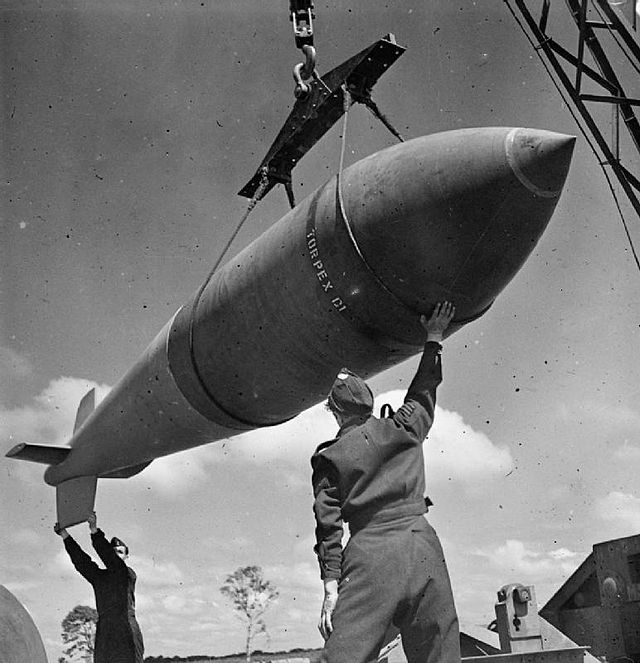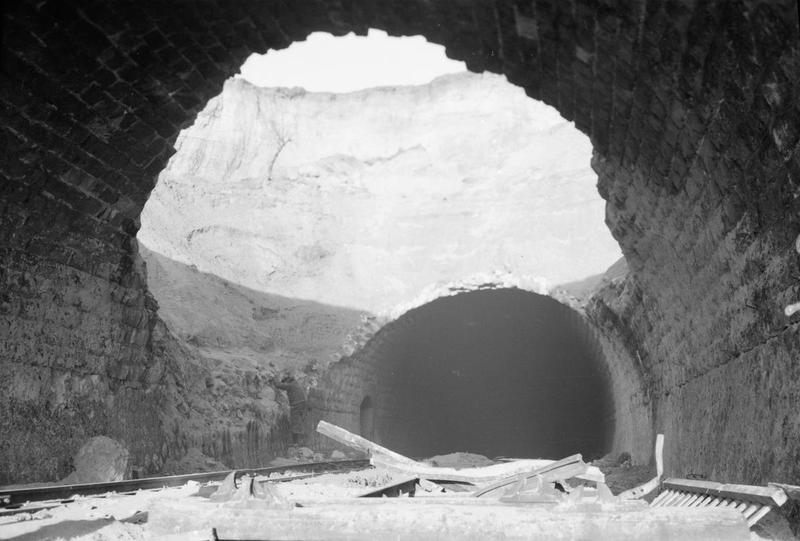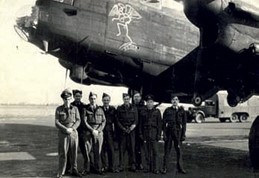Operations
Operations
The First Tallboy
Just days after D-Day, the first 12,000-pound ‘Tallboy’ bombs were dropped by No.617 Squadron on a railway tunnel near Saumur, in an effort to block the tunnel and prevent the railway line from being used by German reinforcements being transported to the invasion area.

RAF ground crew handling a Tallboy at 617 Squadron, Woodhall Spa
(Credit: Imperial War Museum).
The Tallboy was vastly different to the blast bombs used by the RAF until that time. Traditional drum-like bombs could not be aimed with precision. Barnes Wallis, of the bouncing bomb fame, had hypothesised that a very large bomb exploding deep underground next to a target would transmit the shock into the foundations of the target, particularly since shock waves are transmitted through the ground more strongly than through air.
To achieve this, the Tallboy was designed aerodynamically to reach a high terminal velocity, capable of drilling through concrete and exploding underground, creating greater damage.
The Tallboy was 21 feet in length and 38 inches at its maximum diameter. Its hardened steel case had a thickness of more than 4 inches in the nose. The tail of the bomb was made of aluminum. The weapon was filled with 5200 pounds of Torpex explosive and the actual detonation could be delayed up to sixty minutes.
Canadian F/O Don Cheney remembered a convoy of large flatbed lorries arriving on squadron, each with long, tapering shapes, covered by canvas. Initial speculation was that these were knocked-down Spitfires intended to be reassembled as fighter cover for daylight operations for the squadron “To our amazement the largest, most aerodynamic projectiles we had ever seen or even imagined were quickly unloaded and stowed in the bomb dump” he recorded.
Nineteen Tallboy-equipped and six conventionally equipped Lancasters of 617 Squadron attacked the Saumur rail tunnel on the night of 8/9 June 1944, guided on to the target by 83 Squadron Pathfinder Force.
Because the 617 crews lacked practice in using Tallboys, operation estimates expected that only 60% of the bombs would fall in the target area. The results were much better, a reconnaissance flight the following day, identified eighteen craters within two hundred metres from the tunnel mouth. Locals reported that these craters were fifteen metres deep and had a width of 35-40 metres. The Tallboys driven into the ground had created the expected earthquake effect, bringing down massive amounts of rock and dirt from the mountainside to cover the track.
New Zealander Terry Kearns was one of the pilots, a newspaper cutting later reported that ‘Kearns… scored a bull’s eye with his ‘Tallboy’ – a 12,000lb earthquake bomb. He was so accurate that he obliterated the squadron commander Leonard Cheshire’s marking flare, preventing other Lancaster crews from seeing their target. ‘Hold on chaps,’ Cheshire said. ‘I’ll have to mark it again.
Kearns (third from left) with 617 Squadron, Woodhill Spa, 1944.
The motif of the saint holding a bomb on the side of the Lancaster was the design of Kearns. His crew had it emblazoned on their flying jackets.
(Credit: NZBCA Archives).
The line was destroyed—one Tallboy bored through the hillside and exploded in the tunnel about 60 ft (18 m) below, completely blocking it. As a result, the movement of the 17. SS-Panzer Grenadier-Division to Normandy was badly delayed. Five trains full of troops and equipment were held up. They had to proceed to Normandy by road and arrived in groups later and less well-organised.

The gap in the Saumur tunnel roof caused by a direct hit from a Tallboy.
(Credit: Imperial War Museum)
By the end of the war, a total of 854 Tallboys had been dropped on heavily reinforced V-1 and V-2 assembly and launch sites, submarine pens, tunnels, oil refining and storage sites, viaducts, canals, and bridges. Its most spectacular success was with the sinking of the Battleship Tirpitz.
